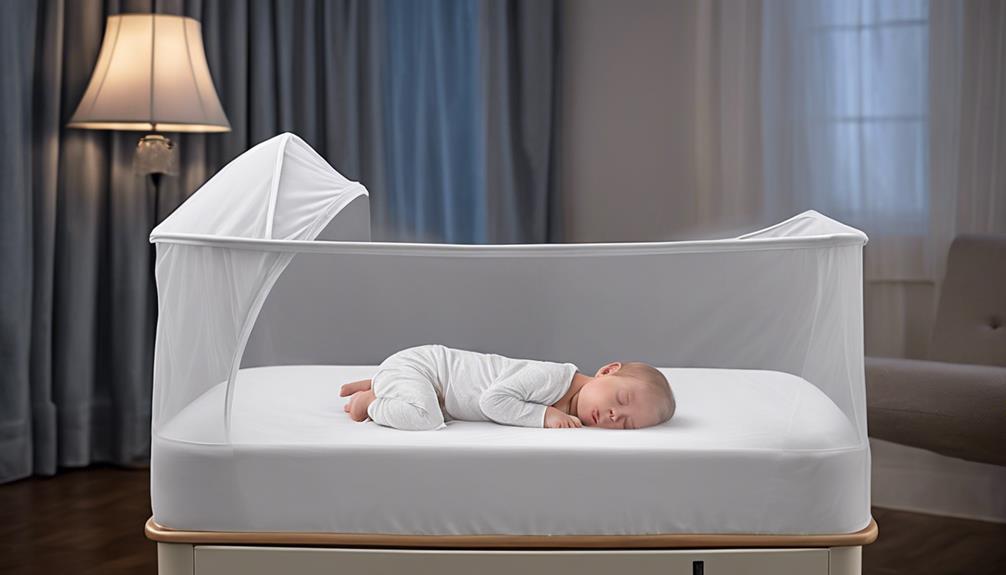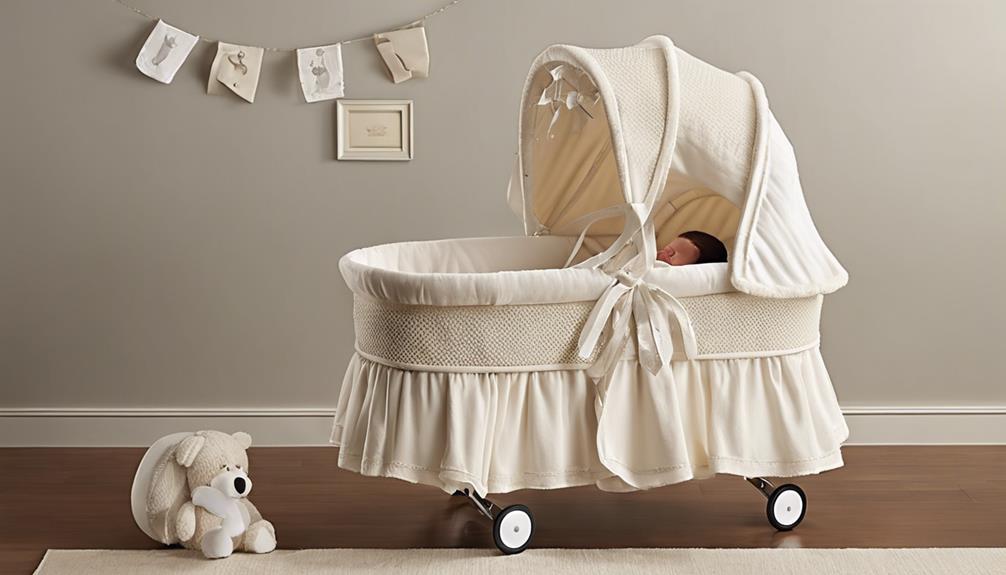Imagine your newborn nestled in a cozy bassinet, drifting off to sleep with a gentle sigh. But how do we achieve this serene scene?
From setting the perfect sleep environment and establishing a soothing bedtime routine, there are key steps to take.
By understanding the nuances of your baby's sleep needs and implementing simple strategies, you can pave the way for peaceful slumber in the bassinet.
Key Takeaways
- Prioritize a firm mattress and safe sleep practices to reduce risks and ensure peaceful sleep.
- Establish a calming bedtime routine with soothing activities for a peaceful sleep environment.
- Maintain a consistent nap schedule and environment to encourage restful daytime sleep.
- Address common reasons for discomfort like reflux or overstimulation to promote peaceful sleep in the bassinet.
Importance of Sleeping in a Bassinet
When it comes to ensuring your newborn's safety and promoting healthy sleep habits, sleeping in a bassinet is essential. Placing your baby on their back on a firm mattress in a bassinet not only meets safety standards but also helps reduce the risk of Sudden Infant Death Syndrome (SIDS).
Room-sharing with a bassinet can provide peace of mind, as it allows you to keep a close eye on your little one while creating a safe sleep environment. Bassinets offer a simple, flat surface without any extra items, aligning perfectly with safe sleep guidelines for newborns.
Common Reasons for Baby's Discomfort

Acid reflux and gas discomfort often disrupt a baby's peaceful sleep in a bassinet, causing restlessness and resistance to settling down.
Overstimulation from bright lights, loud noises, or excessive activity can overwhelm a baby, leading to discomfort and difficulty calming down for sleep.
Inadequate swaddling or improper positioning may make babies feel insecure and uncomfortable in the bassinet, hindering their ability to relax.
Sensitivity to room temperature changes can also play a role in a baby's comfort level, potentially disturbing their sleep in the bassinet.
Discomfort from wet diapers or hunger can further contribute to a baby's restlessness and reluctance to sleep peacefully.
Addressing these common reasons for a baby's discomfort can help create a more conducive environment for restful sleep in the bassinet, promoting a better night's rest for both baby and parents.
Creating a Safe Sleep Environment

To guarantee a safe sleep environment for your newborn in the bassinet, prioritize the use of a firm, flat mattress and avoid any loose bedding or soft items that could pose suffocation risks. It's essential to keep the bassinet free of items that may obstruct your baby's breathing during sleep. Remember to place the bassinet in your room for the first 6-12 months to promote safe sleep practices and reduce the risk of SIDS. Maintaining a room temperature between 68-72 degrees Fahrenheit provides ideal sleep conditions for your little one. Following the ABCs of safe sleep – Alone, on their Back, and in a Crib (or bassinet) – is key to minimizing sleep-related accidents. Ensuring a safe sleep space for your newborn not only promotes better sleep but also offers you peace of mind as a parent.
| Safe Sleep Practices | Importance |
|---|---|
| Firm Mattress | Reduces SIDS risk |
| Room Temperature | Ideal sleep conditions |
| ABCs of Safe Sleep | Minimizes accidents |
Establishing a Bedtime Routine

Wondering how to create a soothing bedtime routine for your newborn to encourage peaceful sleep in the bassinet? Establishing a consistent bedtime routine is key to helping your little one understand when it's time to settle down for the night.
Here are some tips to help you establish a calming bedtime routine:
- Incorporate Calming Activities: Consider giving your baby a warm bath or a gentle massage before bedtime. These activities can help relax your newborn and signal that it's time to wind down.
- Create a Peaceful Environment: Use soft lighting and play soothing music in the background to create a tranquil atmosphere. This can help your baby relax and prepare for sleep.
- End the Day with Comforting Rituals: Reading a bedtime story or singing a lullaby can be comforting ways to end the day and shift to sleep. These rituals can become cues that signal to your baby that it's time to rest in the bassinet.
Encouraging Daytime Naps

Establishing a soothing bedtime routine for your newborn can also contribute to fostering a conducive environment for encouraging daytime naps in the bassinet. Consistent nap times throughout the day help your baby recognize when it's time to rest. Creating a peaceful setting with minimal distractions is key to promoting successful daytime naps.
Using similar settling techniques for both daytime and nighttime sleep can aid in associating the bassinet with relaxation for your little one. It's important to pay attention to your baby's sleep cues to prevent overtiredness, which can hinder nap time. Implementing a gentle wind-down routine before each nap can signal to your newborn that it's time to sleep in the bassinet.
Conclusion
To wrap up, by creating a safe and soothing sleep environment in a bassinet, you can help your newborn sleep peacefully.
Remember to establish a bedtime routine and encourage daytime naps to promote healthy sleep habits.
With consistency and patience, you'll find that your little one will soon settle into a peaceful sleep routine in their cozy bassinet.
Sweet dreams await both baby and parent as you commence on this journey together.









